



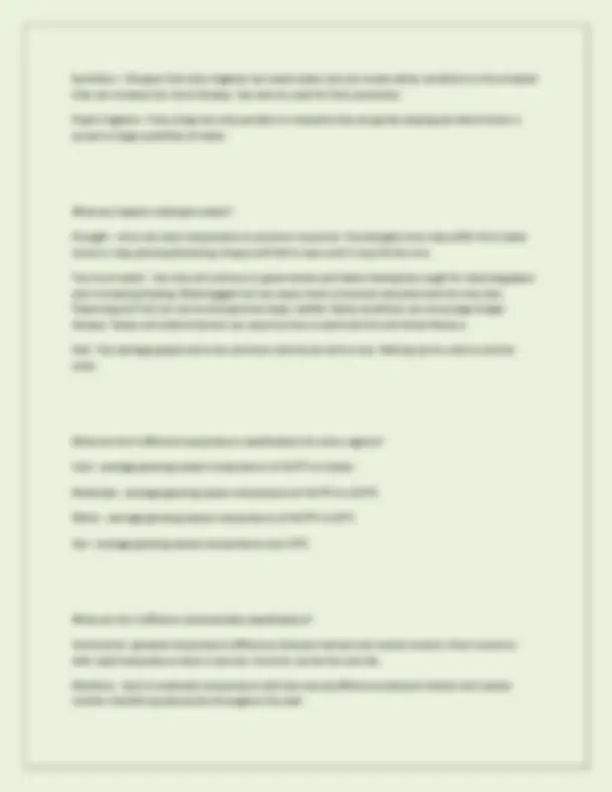
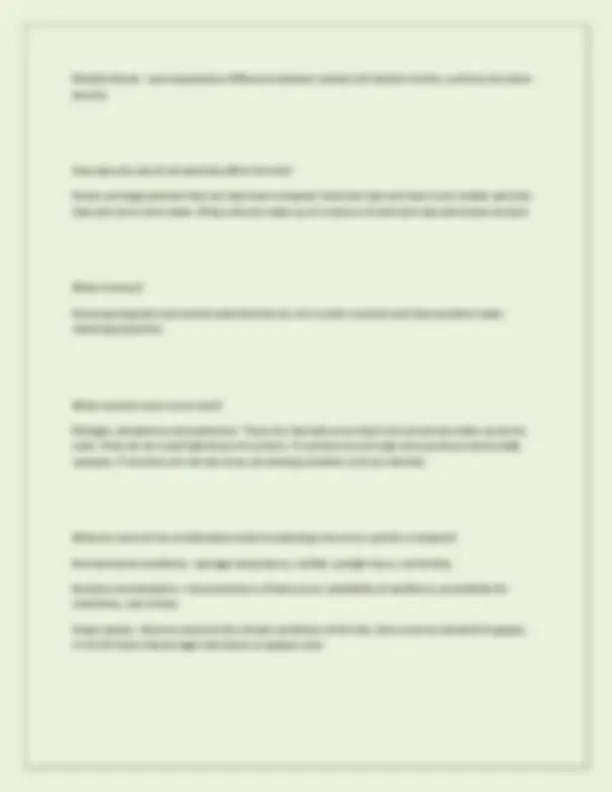
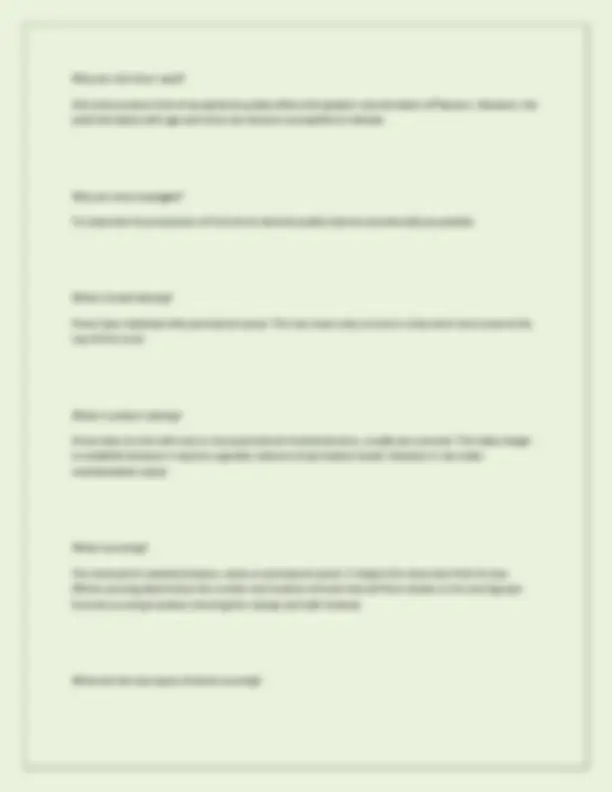
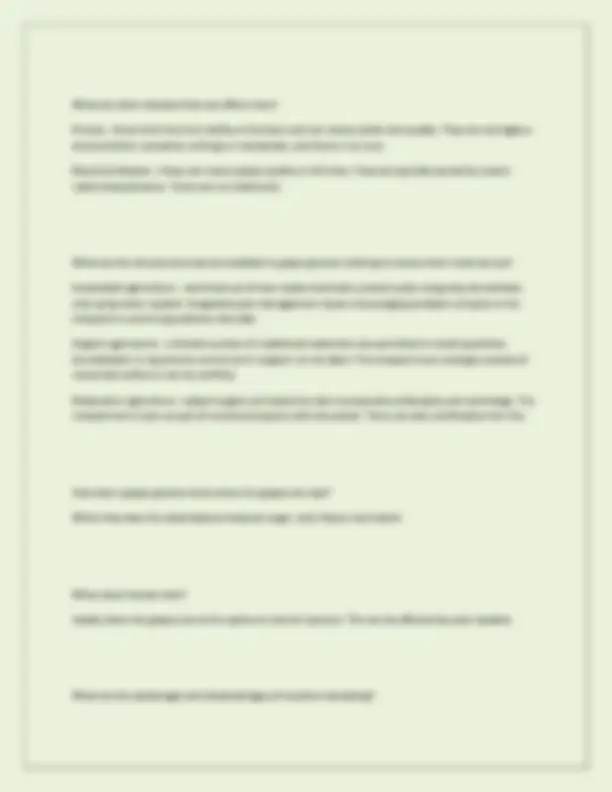
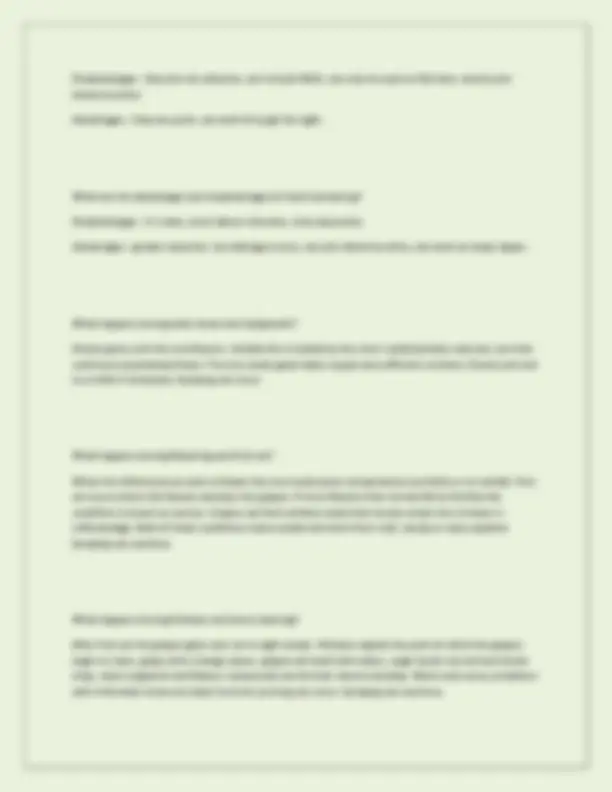
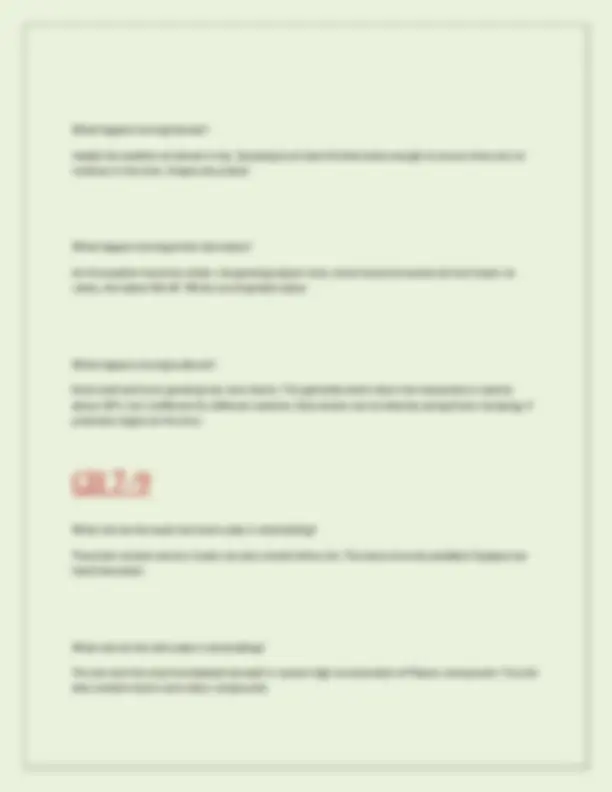
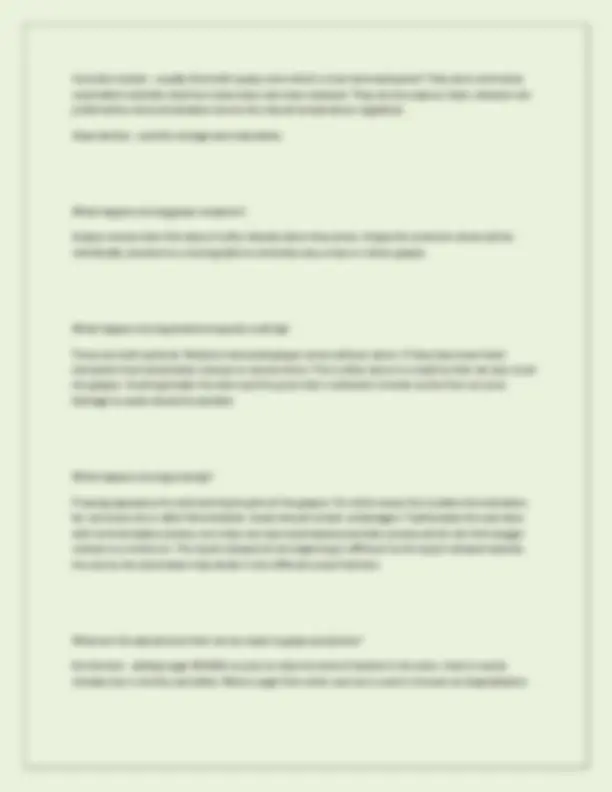
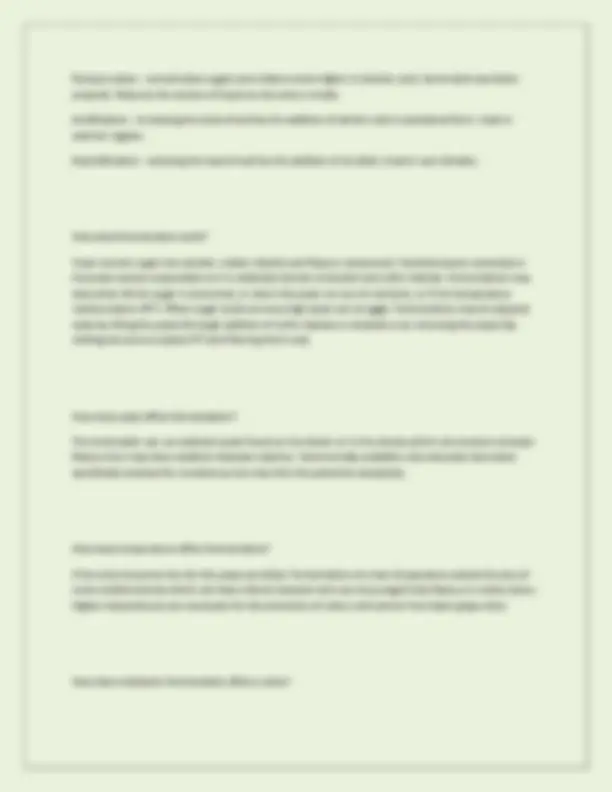
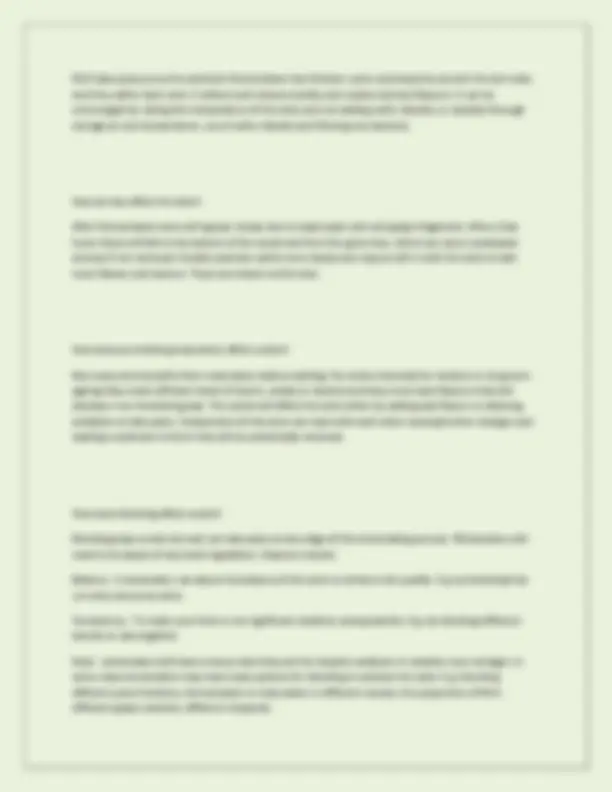
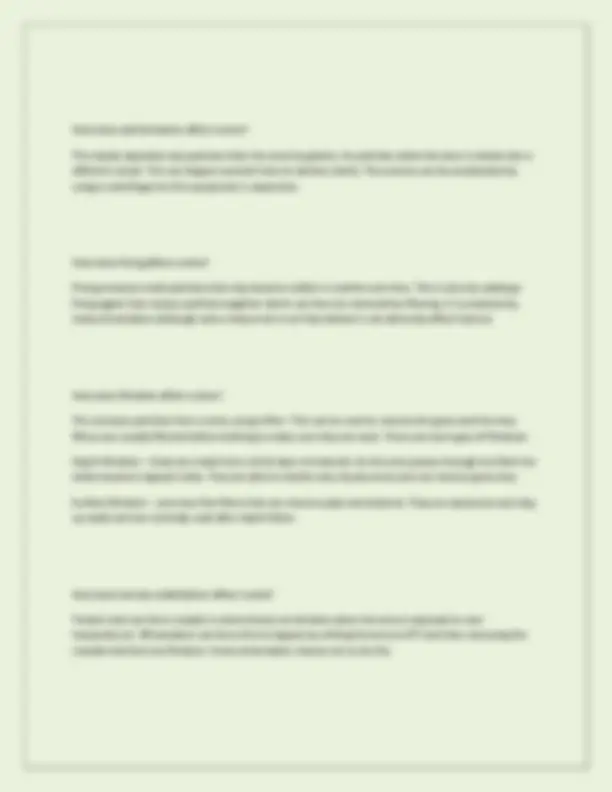
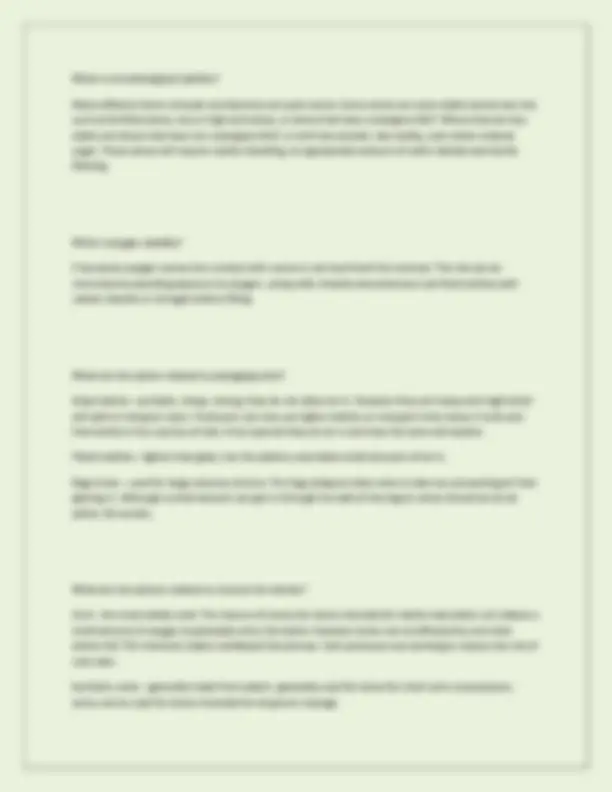
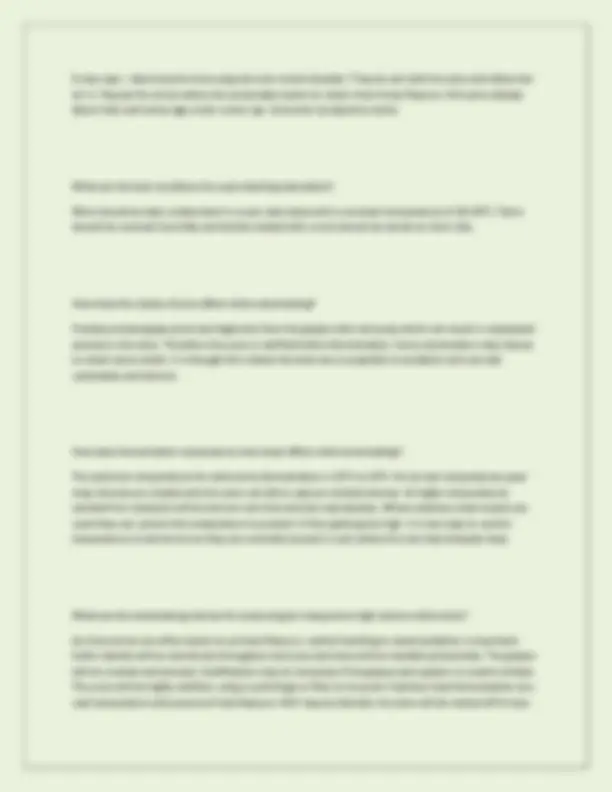
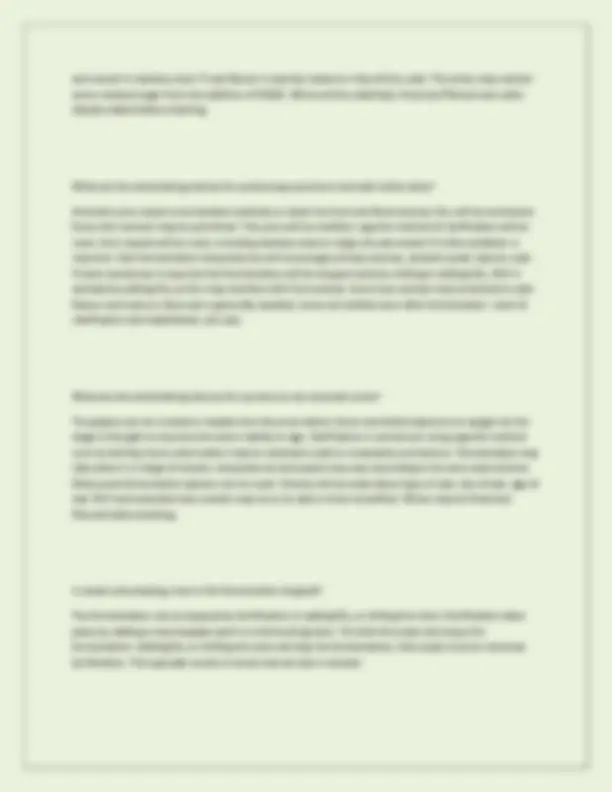

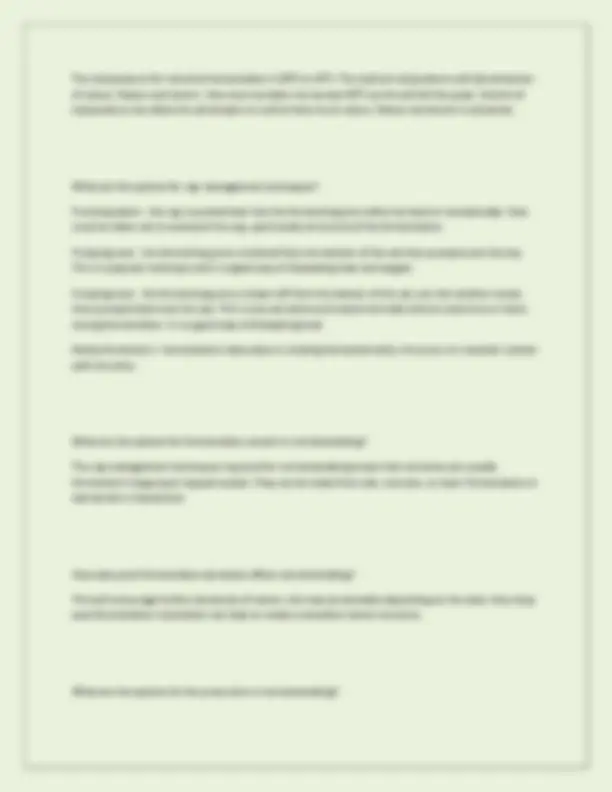
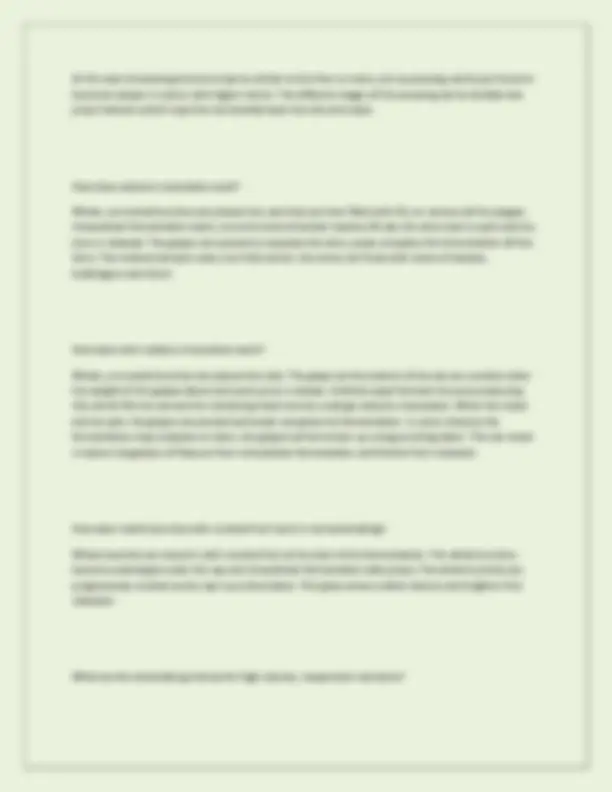
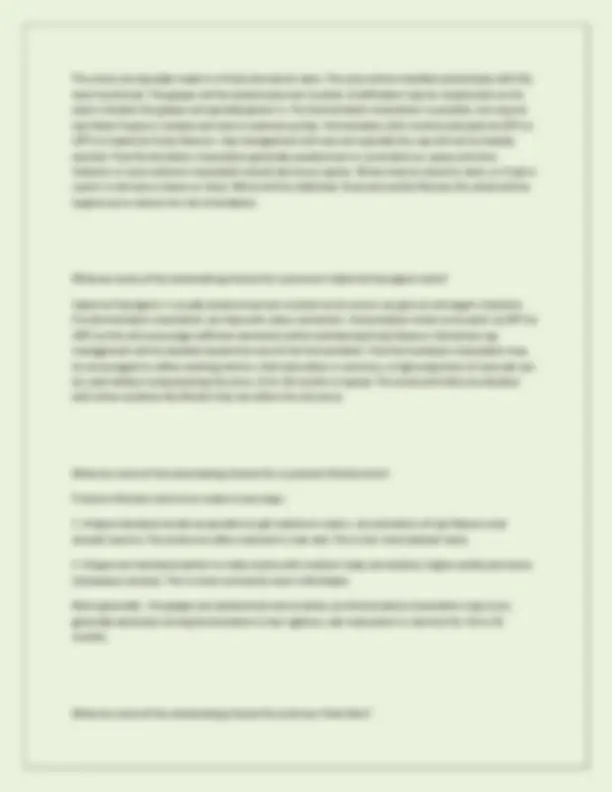
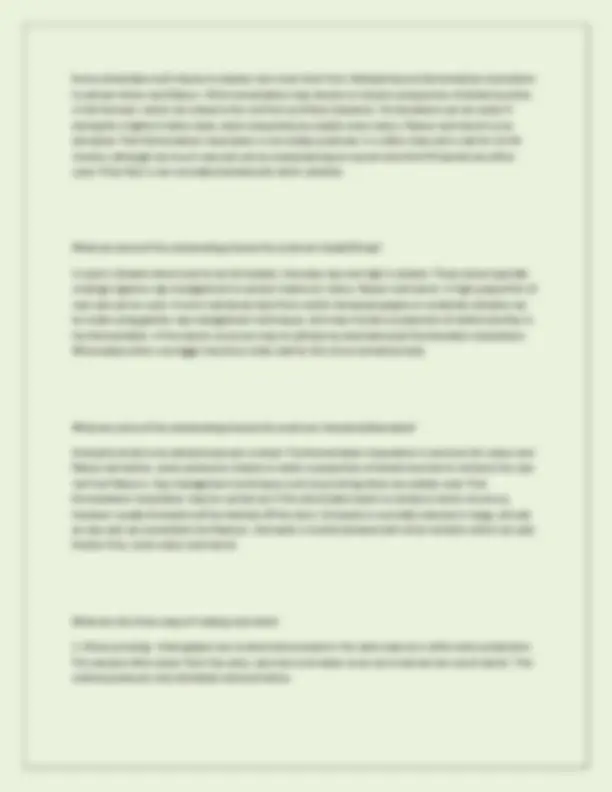



Study with the several resources on Docsity

Earn points by helping other students or get them with a premium plan


Prepare for your exams
Study with the several resources on Docsity

Earn points to download
Earn points by helping other students or get them with a premium plan
Community
Ask the community for help and clear up your study doubts
Discover the best universities in your country according to Docsity users
Free resources
Download our free guides on studying techniques, anxiety management strategies, and thesis advice from Docsity tutors
This document offers a detailed exploration of viticulture, covering key aspects of grape cultivation, from vine selection and propagation to environmental factors influencing grape quality. it delves into the intricacies of vineyard management, including pruning techniques, irrigation methods, and pest control. The document also touches upon the classification of wine regions based on temperature and continentality, providing a solid foundation for understanding the relationship between terroir and wine production. the included questions and answers further enhance its educational value, making it a valuable resource for students of viticulture and enology.
Typology: Exams
1 / 30

This page cannot be seen from the preview
Don't miss anything!























What is the name of the main Eurasian vine species for winemaking? Vitis vinifera. Why are American vines used? American vines are widely used for their rootstocks rather than producing grapes for winemaking. What are some of the factors a grape grower will consider when trying to decide which grape variety to select? Budding and ripening times, resistance to disease. Why are vines grown from cuttings? To grow a new vine that is the same variety. If seeds are used they would grow into a different variety. What is a clone? A mutation of a grape variety that has a small difference to the original and is still genetically identical.
Why might a new grape variety be created? To thrive in certain climates and soil conditions, or have improved disease resistance, or be able to deliver higher quality or quantity of grapes. How are new grape varieties created? Cross fertilisation of flowers from different vines. What is a crossing? Give an example of a crossing. A new variety produced from vitis vinifera vines. An example is Pinotage (Pinot Noir x Cinsault). What is a hybrid? Give an example of a hybrid. A variety whose parents come from two different vine species. Typically at least one parent is an American vine. They are often used for rootstocks. An example used for winemaking is Vidal. What is phylloxera? What does it to vineyards and how is it prevented? Phylloxera is an insect. It feeds on the roots of vines where infections can enter which kills the vine. It is prevented by grafting American rootstocks to vines. What are some of the reasons to use rootstocks? Because they can provide resistance to Phylloxera, protection against nematodes, resistance to drought conditions.
What is important about managing the one-year-old wood on the vine? Pruning it into a cane or spur after winter to determine the number of buds for the next years growth. What is the function of the roots of the vine? Absorb water and nutrients from the soil, anchor the vine and store carbohydrates. Why is heat important for vines? Vines need heat to function. If it is too cold the vine will not grow or will struggle to survive. Vines need at least 10°C to grow. The amount of heat will determine which grape variety will grow in a region. How does latitude affect the heat of a region? The closer to the equator a region is the warmer it is. The further away a region is from the equator the cooler it is. Most vineyards are between the latitudes 30° and 50°. How does altitude affect the heat of a region? Temperature decreases as altitude increases. How do ocean currents affect the temperature of a region? Warm or cold currents transport large volumes of water across the surface of the ocean leading to localised warming or cooling.
How does fog affect the temperature of a region? Fog can help cool an area of a warm climate region that may otherwise struggle to produce high quality grapes. How does soil affect the temperature of a region? Soils that are dark in colour or stony can absorb and reradiate heat, which can aid ripening. Soils that have a high water content conduct heat away from the vine more quickly, which can delay budburst. How does aspect affect the temperature of a vineyard? Vineyards facing toward the equator will receive more heat. This can aid ripening in cool climates. Steeper slopes will benefit even more from this effect. What is continentality? The temperature difference between the coldest and hottest months. Regions with high continentality will have a greater difference in seasonal temperatures. Large bodies of water will reduce continentality. Continentality will determine the length of the growing season and the total amount of heat available to the vine. What is the diurnal range? The difference between day and night temperature. Cool nights help slow the loss of aromas and acidity in the grapes during ripening. Regions that are next to a body of water or are cloudy will have less diurnal range
How do seas and lakes affect sunlight? Vineyards near to large bodies of water experience more cloud cover. Vineyards above rivers or lake can benefit from sunlight reflected from the surface of the water. How does aspect affect sunlight? Aspect affects the amount of sunlight a vineyard receives. Steeper slopes have a greater affect. Vineyards that face the Equator will receive more sunlight, this can be especially important in vineyards further away from the Equator. What are the hazards relating to sunlight? Low levels of light can be a problem during flowering and fruit set where it can result in a smaller crop of grapes. If it is too sunny grapes can suffer from sunburn leading to bitter flavours. How does water affect vines? The vine needs water for photosynthesis, and to swell its grapes during ripening. The vine accesses water through it's roots. The amount of water needed will be determined by the temperature, vines need more water in warmer temperatures. Once enough leaves have grown limiting the supply of water can be beneficial for ripening. What are the different types of irrigation? Drip - the most advanced and expensive. Computer controlled so each vines gets only as much water as it needs.
Sprinklers - Cheaper than drip irrigation but waste water and can create damp conditions in the vineyard that can increase the risk of disease. Can also be used for frost protection. Flood irrigation - Very cheap but only possible in vineyards that are gently sloping and where there is access to large quantities of water. What are hazards relating to water? Drought - vines can stop transpiration to preserve resources. If prolonged vines may suffer from water stress or stop photosynthesising. Grapes will fail to ripen and it may kill the vine. Too much water - the vine will continue to grow shoots and leaves leaving less sugar for ripening grapes and increasing shading. Waterlogged soil can cause roots to become saturated and the vine dies. Flowering and fruit set can be disrupted by heavy rainfall. Damp conditions can encourage fungal disease. Heavy rain before harvest can cause berries to swell and this will dilute flavours. Hail - Can damage grapes and vines and even destroy an entire crop. Netting can be used to protect vines. What are the 4 different temperature classifications for wine regions? Cool - average growing season temperature of 16.5°C or below. Moderate - average growing season temperature of 16.5°C to 18.5°C. Warm - average growing season temperature of 18.5°C to 21°C. Hot - average growing season temperature over 21°C. What are the 3 different continentality classifications? Continental - greatest temperature difference between hottest and coolest months. Short summers with rapid temperature drop in autumn. Summer can be hot and dry. Maritime - Cool to moderate temperature with low annual difference between hottest and coolest months. Rainfall spread evenly throughout the year.
Why are 'old vines' used? Old vines produce fruit of exceptional quality often with greater concentration of flavours. However, the yield decreases with age and vines can become susceptible to disease. Why are vines managed? To maximise the production of fruit at the desired quality level as economically as possible. What is head training? Vines have relatively little permanent wood. This can mean only a trunk or a few short arms around the top of the trunk. What is cordon training? Vines have a trunk with one or more permanent horizontal arms, usually spur pruned. This takes longer to establish because it requires a greater amount of permanent wood. However it can make mechanisation easier. What is pruning? The removal of unwanted leaves, canes or permanent wood. It shapes the vines and limits its size. Winter pruning determines the number and location of buds that will form shoots in the coming year. Summer pruning involves trimming the canopy and leaf removal. What are the two types of winter pruning?
Spur pruning - spurs are short sections of one year old wood that have two to three buds. These will be distributed along a cordon or around the head of the vine. Replacement cane pruning - Canes are longer sections of one year old wood with eight to twenty buds. These are often tied to a trellis. Why would a grape grower choose not to use a trellis system? Untrellised vines (bush vines) are better suited to warm or hot, dry and sunny regions where the extra shade can help protect the grapes. In cool or wet regions the shade can impede ripening and lack of airflow can promote disease. Why would a grape grower choose to use a trellis? The arrangement of shoots can help control how much sunlight reaches the grapes. An open canopy will have better air circulation. Trellising will aid mechanisation. What is VSP? Vertical shoot positioning. The shoots are trained vertically and tied into place on the trellis. What is planting density? The number of vines planted in a given area What are the factors that affect planting density? Availability of water and nutrients.
What are other diseases that can affect vines? Viruses - these limit the vine's ability to function and can reduce yields and quality. They are contagious and persistent, spread by cuttings or nematodes, and there is no cure. Bacterial diseases - these can reduce grape quality or kill vines. They are typically spread by insects called sharpshooters. There are no treatments. What are the viticultural practices available to grape growers wishing to reduce their chemical use? Sustainable agriculture - restricted use of man made-chemicals, prevent pests using natural methods, only spray when needed. Integrated pest management means encouraging predators of pests in the vineyard to control populations naturally. Organic agriculture - a limited number of traditional treatments are permitted in small quantities. Accreditation is required to use the term 'organic' on the label. The vineyard must undergo a period of conversion before it can be certified. Biodynamic agriculture - adopts organic principles but also incorporates philosophy and cosmology. The vineyard soil is seen as part of connected system with the planet. There are also certifications for this. How does a grape grower know when the grapes are ripe? When they have the ideal balance between sugar, acid, flavour and tannin. When does harvest start? Ideally when the grapes are at the optimum level of ripeness. This can be affected by poor weather. What are the advantages and disadvantages of machine harvesting?
Disadvantages - they are not selective, can include MOG, can only be used on flat land, cannot pick whole bunches. Advantages - they are quick, can work through the night. What are the advantages and disadvantages of hand harvesting? Disadvantages - It is slow, more labour intensive, more expensive. Advantages - greater selection, less damage occurs, can pick whole bunches, can work on steep slopes. What happens during early shoot and leaf growth? Shoots grow until the vine flowers. Initially this is fuelled by the vine's carbohydrates reserves, but then continues via photosynthesis. The vine needs good water supply and sufficient nutrients. Shoots are tied to a trellis if necessary. Spraying can occur What happens during flowering and fruit set? When the inflorescences start to flower the vine needs warm temperatures and little or no rainfall. Fruit set occurs when the flowers develop into grapes. If more flowers than normal fail to fertilise the condition is known as coulure. Grapes can form without seeds that remain small, this is known is millerandage. Both of these conditions reduce yields and stem from cold, cloudy or rainy weather. Spraying can continue. What happens during Véraison and berry ripening? After fruit set the grapes grow over six to eight weeks. Véraison signals the point at which the grapes begin to ripen, grape skins change colour, grapes will swell with water, sugar levels rise and acid levels drop, colour pigments and flavour compounds are formed, tannins develop. Warm and sunny conditions with mild water stress are ideal. Summer pruning can occur. Spraying can continue.
What role does the pulp play in winemaking? Water is largest component of the pulp, and therefore in the wine. The sugar gets fermented into alcohol. Acids are present (e.g. tartaric, malic) which will also be present in the wine. What role does the bloom play in winemaking? The bloom is the waxy surface that covers the skins of the grapes and contains yeasts that can be used to ferment the wine. What role does oxygen play in winemaking and maturation? Oxygen can react with grape juice or wine. It can have positive and negative effects. Oxygen in winemaking - many winemakers seek to reduce contact with oxygen in winemaking as it can affect fruity flavours. Using antioxidants such as sulfur dioxide, picking at night, using air tight vessels are all ways to reduce the effect of oxygen. This can be referred to as protective or anaerobic winemaking. Oxygen in maturation - wines can be matured in airtight vessels. Wines that are matured aerobically are stored in wood. Oak is watertight but not airtight. Small amounts of oxygen can help soften the tannins and give more complexity, primary fruit flavours will fade and tertiary characteristics will develop. Wine styles - some wines have pronounced oxidative character e.g. Oloroso Sherry, Tawny Port. For most wines too much oxygen exposure can be damaging. What role does sulfur dioxide play in winemaking? Sulfur dioxide acts as an antioxidant and an antiseptic agent. It's levels are adjusted during winemaking. The upper levels are strictly controlled by law. While some is naturally produced during fermentation, most winemakers agree that keeping additions as low as possible is preferable. A very small number of winemakers refuse to use any.
How do oak vessels affect wine? Oak is used in fermentation and maturation. Oak allows a small level of oxidation while the wine is maturing to allow tertiary aromas to develop. The wine can extract tannin from the oak. Oak can also give aromas and flavours to the wine such as vanilla and cloves. Hygiene is important, tainted wood can ruin wines. What are the options related to oak a winemaker can consider? Species and origin of oak - different species have different characteristics. Most oak vessels are made from European or American oak. France is considered to produce the finest oak. Size - small vessels (e.g. 225 litre barrique) have a greater effect on the wine than larger vessels because more of the wine is in contact with the surface of the barrel. Production of barrel - the toasting of the barrel has an impact on the wine. When barrels are produced staves are heated, this also transforms the tannins and flavours giving notes of sweet spice and toast. The level of toasting affects what flavours the barrel contributes to the wine. Age - the effect of toasting reduces each time a barrel is used. A barrel that is used once gives less flavour that a new one. By the fourth use a barrel imparts little flavour. What are oak alternatives? Instead of using barrels winemakers can use oak staves or oak chips which are inserted into an inert winery vessel. Both methods can provide some aroma and tannin at a much lower cost. The oxidative effects of barrel ageing can be replicated by adding small quantities of oxygen to the wine vessel. What the options for inert winery vessels? These are vessels that do not add flavour to wines or allow oxidation. They are widely used for fermentation and are often used to store wines before bottling. Stainless steel - most modern winery vessels are made from this. They are easy to clean, can be made in any shape and size, and can incorporate temperature control mechanisms.
Remove water - concentrates sugars and makes a wine higher in alcohol, acid, tannin (and any faults present). Reduces the volume of liquid so less wine is made. Acidification - increasing the level of acid by the addition of tartaric acid in powdered form. Used in warmer regions. Deacidification - reducing the level of acid by the addition of an alkali. Used in cool climates. How does fermentation work? Yeast convert sugar into alcohol, carbon dioxide and flavour compounds. Saccharomyces cerevisiae is the yeast species responsible as it is relatively tolerant of alcohol and sulfur dioxide. Fermentation may stop when all the sugar is consumed, or when the yeast run out of nutrients, or if the temperature reaches above 35°C. When sugar levels are very high yeast can struggle. Fermentation may be stopped early by killing the yeast (through addition of sulfur dioxide or alcohol) or by removing the yeast (by chilling the wine to below 5°C and filtering them out). How does yeast affect fermentation? The winemaker can use ambient yeast found on the bloom or in the winery which can produce complex flavours but may have variation between batches. Commercially available cultured yeast have been specifically selected for consistency but may limit the potential complexity. How does temperature affect fermentation? If the wine becomes too hot the yeast are killed. Fermentation at a low temperature avoids the loss of more volatile aromas which can have a floral character and can encourage fruity flavours in white wines. Higher temperatures are necessary for the extraction of colour and tannin from black grape skins. How does malolactic fermentation affect a wine?
MLF takes place once the alcoholic fermentation has finished. Lactic acid bacteria convert the tart malic acid into softer lactic acid. It softens and reduces acidity and creates buttery flavours. It can be encouraged by raising the temperature of the wine and not adding sulfur dioxide, or avoided through storage at cool temperature, use of sulfur dioxide and filtering out bacteria. How do lees affect the wine? After fermentation wine will appear cloudy due to dead yeast cells and grape fragments. After a few hours these will fall to the bottom of the vessel and form the gross lees, which can cause unpleasant aromas if not removed. Smaller particles settle more slowly and may be left in with the wine to add more flavour and texture. These are known as fine lees. How does pre-bottling maturation affect a wine? Not every wine benefits from maturation before bottling. For wines intended for medium or long term ageing they need sufficient levels of tannin, acidity or alcohol and they must have flavours that will develop in an interesting way. The vessel will affect the wine either by adding oak flavour or allowing oxidation to take place. Components of the wine can react with each other causing further changes and leading a sediment to form that will be periodically removed. How does blending affect a wine? Blending plays a vital role and can take place at any stage of the winemaking process. Winemakers will need to be aware of any local regulations. Reasons include: Balance - A winemaker can adjust the balance of the wine to enhance the quality. E.g. by blending free run wine and press wine. Consistency - To make sure there is not significant variation among bottles. E.g. by blending different barrels or vats together Style - winemakers will have a house style they aim for despite variations in weather over vintages. In some cases winemakers may have many options for blending to achieve this style. E.g. blending different press fractions, fermentation or maturation in different vessels, the proportion of MLF, different grape varieties, different vineyards.